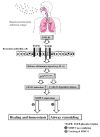Bioaerosols from a food waste composting plant affect human airway epithelial cell remodeling genes
- PMID: 24368426
- PMCID: PMC3924447
- DOI: 10.3390/ijerph110100337
Bioaerosols from a food waste composting plant affect human airway epithelial cell remodeling genes
Abstract
The composting procedure in food waste plants generates airborne bioaerosols that have the potential to damage human airway epithelial cells. Persistent inflammation and repair responses induce airway remodeling and damage to the respiratory system. This study elucidated the expression changes of airway remodeling genes in human lung mucoepidermoid NCI-H292 cells exposed to bioaerosols from a composting plant. Different types of microorganisms were detectable in the composting plant, using the agar culture method. Real-time polymerase chain reaction was used to quantify the level of Aspergillus fumigatus and the profile of remodeling genes. The real-time PCR results indicated that the amount of A. fumigatus in the composting hall was less than 10(2) conidia. The endotoxins in the field bioaerosols were determined using a limulus amebocyte lysate test. The endotoxin levels depended on the type of particulate matter (PM), with coarse particles (2.5-10 μm) having higher endotoxin levels than did fine particles (0.5-2.5 μm). After exposure to the conditioned medium of field bioaerosol samples, NCI-H292 cells showed increased pro-inflammatory interleukin (IL)-6 release and activated epidermal growth factor receptor (EGFR), transforming growth factor (TGF)-β1 and cyclin-dependent kinase inhibitor 1 (p21 WAF1/CIP1) gene expression, but not of matrix metallopeptidase (MMP)-9. Airborne endotoxin levels were higher inside the composting hall than they were in other areas, and they were associated with PM. This suggested that airborne bioaerosols in the composting plant contained endotoxins and microorganisms besides A. fumigatus that cause the inflammatory cytokine secretion and augment the expression of remodeling genes in NCI-H292 cells. It is thus necessary to monitor potentially hazardous materials from bioaerosols in food composting plants, which could affect the health of workers.
Figures





References
-
- De Bertoldi M., Vallini G., Pera A. The biology of composting: A review. Waste Manag. Res. 1983;1:157–176.
-
- New Worker Health and Occupational Safty: A Report of the Work Group Convened by NIOSH, May 5, 1995, to Identify Priorities for Hired Farm Worker Occupational Health Surveillance and Research. NIOSH; Atlanta, GA, USA: 1995.
-
- Lancey J., Dutkiewicz J. Bioaerosols and occupational lung disease. J. Aerosol Sci. 1994;25:1371–1404. doi: 10.1016/0021-8502(94)90215-1. - DOI
MeSH terms
Substances
LinkOut - more resources
Full Text Sources
Other Literature Sources
Research Materials
Miscellaneous

